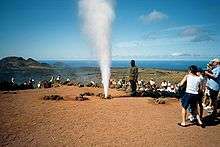National Parks Autonomous Agency
The National Parks Autonomous Agency (OAPN) is an agency of the Spanish central government that manages the National Parks Network and the Spanish Biosphere Reserves Network, as well as mountains, farms and other patrimonial assets of its property. The agency was created on June 23, 1995 by the Agriculture Minister Luis María Atienza by merging two other agencies, the Institute for the Conservation of Nature (ICONA) and the National Institute for Agrarian Reform and Development (IRYDA).[1]
| Organismo Autónomo de Parques Nacionales | |
| Agency overview | |
|---|---|
| Formed | June 23, 1995 |
| Preceding agencies |
|
| Type | Autonomous agency |
| Jurisdiction | Spanish government |
| Headquarters | 59 Hernani Street Madrid |
| Agency executive |
|
| Parent department | Ministry for the Ecological Transition |
| Website | Web Site(in Spanish) |
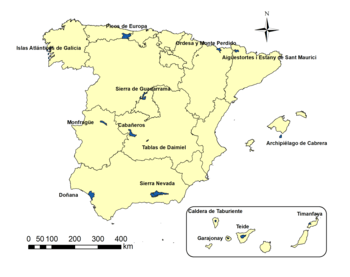
The OAPN is an agency of the Spanish Ecological Transition Department. The Minister and the Secretary of State for Environment act as President and Vice President of the agency, respectively although the chief executive of the agency is the Director. The current director is Juan José Areces Maqueda, appointed on July 29, 2018.[2]
Powers
The National Parks Autonomous Agency is responsible for:[3]
- The formulation of the national policy regarding national parks.
- The dissemination and promotion of the image, values, and conservation model of national parks abroad.
- The planning and management of the natural spaces of state competence.
- The management of the mountains, farms and other assets assigned or their ownership.
- The coordination and promotion of the Man and the Biosphere Programme of UNESCO, as well as the promotion, coordination and support of the Biosphere Reserve Network.
- The support to the Ecological Transition Department's policies regarding biodiversity, conservation and sustainable use of natural resources, conservation of fauna, flora, habitat and natural ecosystems in the terrestrial and marine environment. In this sense, it has the same responsibilities in the Department's policies on education, information, awareness, training and public participation on environmental issues through the National Center for Environmental Education (CENEAM).
- The provision to the public of information and documentation services specialized in protected areas, nature conservation, dissemination, communication and environmental education.
- The cooperation with public and private entities, both national (state, regional and local) and international, for the development of the previous functions.
History

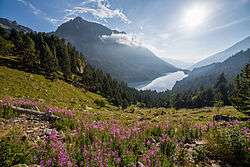
The first National Parks Act was passed on December 8, 1916. This law was one of the very first in Europe dedicated to the protection of nature and it consisted in just three articles. The law, defined the national parks as "those exceptionally picturesque, forested or rugged sites or places of the national territory, which the State consecrates, declaring them such, with the sole purpose of favoring their access through adequate means of communication, and respecting and to ensure that the natural beauty of its landscapes, the richness of its fauna and its flora and the geological and hydrological participles that they enclose are respected, thus avoiding with the greatest efficiency any act of destruction, deterioration or disfigurement by the hand of the man".[4] The first two national parks to be created were the Covadonga Mountain National Park (current Picos de Europa National Park) and the Ordesa Valley National Park (currently named Ordesa y Monte Perdido National Park).[5]
From 1918 to 1954, the National Parks Network was integrated by those two parks. In 1954, two places of the Canary Islands were granted with the rank of national parks, the Teide National Park[6] and the Caldera de Taburiente National Park.[7] A year later, the Aiguas Tortas y Lago de San Mauricio National Park was created.[8]
In 1957, a new Forestry Act was passed and it replaced the old Forestry Act of 1863 and also the National Parks Act of 1916. This new legislation also marks a substantial change in the legislative approach to environmental protection, according to which ecological factors begin to be more important when declaring new parks; in front of the merely historical and landscape.[9] Years later, in 1969, Doñana is declared a National Park[10] and, in 1973, the Tablas of Daimiel.[11] A year later, a new national park is created in the Canary Islands, the Timanfaya National Park.[12]
Other important year for the protection of the Spanish parks is 1975. The Protected Natural Spaces Act is passed which creates three new classifications of protected spaces —Integral Reserves of Scientific Interest, Natural Parks and Natural Parks of National Interest—, in addition to national parks. This law also brings with it the reclassification of several parks, with the notorious expansion of Doñana and Ordesa y Monte Perdido.[13] In the beginning of the 80s, the Garajonay National Park is created, one of the best world representations of the laurel, relict vegetation of the Tertiary Era.[14]
The Natural Spaces and Wild Flora and Fauna Conservation Act of 1989 gave a decisive push to the National Parks Network. This law officially creates the Network and it contained a clause where it is detailed which parks are part of it and their ecosystems. Finally, the law also assumes the right of every person to environment. Following the principles established by this law, in 1991 the Cabrera Archipelago Maritime-Terrestrial National Park[15] is created and in 1995 the Covadonga National Park is extended integrating all the limestone landscape, creating the Picos de Europa National Park.[16] Months later, the Cabañeros National Park is created and integrated into the Network.[17]
During the following years after the approval of this law, there was discomfort among the regions because the law gave the exclusive power to the central government to manage the National Parks. Several regions —Andalusia, Aragón, Balearic Islands, Basque Country, Canary Islands, Cantabria, Castile and León and Catalonia— presented unconstitutionality appeals before the Constitutional Court against the law and other related regulations for this reason. In 1995, the Constitutional Court declared unconstitutional the fifth additional provision of the law[18] and in 1997 the Spanish Parliament reformed the 1989 Act to establish a shared system of managing between the central government and the regions. On June 23, 1995, because of the devolution of powers to the regions, the Minister of Agriculture Luis María Atienza approved a royal decree merging two other agencies, the Institute for the Conservation of Nature (ICONA) and the National Institute for Agrarian Reform and Development (IRYDA) to create the current OAPN.[1]
In 1999 a new national park was created, this time the Sierra Nevada National Park,[19] and in 2002 the Atlantic Islands of Galicia National Park.[20]
Another appeal of unconstitutionality is filed by the regions of Andalusia and Aragón against the 1998 Act. These two regions criticized the shared system. The Constitutional Court was forced to interpret the law and it established in 2004 that the shared system consisted on a day-to-day management by the regions (including the appointment of all the officials and the heads of the national parks) but this management must to be finance by the regional governments, and the superior supervision and coordination of the Network was granted to the central government by giving to it the authority to create or extend national parks and to establish the general guidelines of action.[21]
In March 2007 the Monfragüe National Park was created[22] and, a month later, the National Parks Network Act was passed. The National Parks Network Act of 2007 assumed the interpretation of the Constitutional Court and it granted the supervisory power to the Department of Environment, through its Autonomous Agency. The last national park to be created was the Sierra de Guadarrama National Park on June 25, 2013.[23]
On December 3, 2014 it was approved the current National Parks Act. This law reinforces, for its singularity, the protection of those parks and it establish an improved coordination and support system with the central government. In this sense, the law established an emergency system against environmental disasters and it forbids activities such us sport and recreational fishing, sport and commercial hunting, logging for commercial purposes, as well as urbanization and building.
Directors
| No. | Name | Term of office | |
|---|---|---|---|
| Start | End | ||
| 1 | Jesús Casas Grande | July 15, 1995 | January 26, 1996 |
| 2 | Antonio J. Troya Panduro | March 29, 1996 | September 10, 1996 |
| 3 | Alberto Ruiz del Portal Mateos | September 10, 1996 | October 2, 1999 |
| 4 | Basilio Rada Martínez | July 25, 2000 | June 8, 2004 |
| 5 | Juan Garay Zabala | July 30, 2004 | June 5, 2009 |
| 6 | José Jiménez García-Herrera | June 5, 2009 | December 30, 2009 |
| 7 | Olga Baniandrés | December 30, 2009 | November 18, 2011 |
| 8 | Basilio Rada Martínez | February 2012 | July 19, 2018 |
| 9 | Juan José Areces Maqueda | July 19, 2018 | Incumbent |
National Parks Network
_en_1893.jpg)
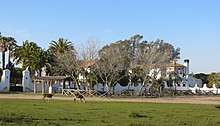
The National Parks Network (RPN) is a system established to protect and manage some Spanish Natural Heritage with the category of national park. The RPN is integrated by 15 national parks and all the staff and administrations that are part of it. The network encompasses approximately 1 million acres (4,050 km²). The largest national park is the Sierra Nevada National Park with 212,222 acres (858,8 km²) and it is surrounded by the Sierra Nevada Natural Park, that is approx. 200,000 acres.[24] The smallest park is the Tablas de Daimiel National Park at 7,487 acres (30,3 km²).[25]
In addition to the national parks, that are directly managed by the Spanish regional administrations, the National Parks Autonomous Agency (OAPN) administers other properties. The OAPN administers 18 properties that encompasses 247,105.40 acres (1,000 km² approx.). All these properties have in common the fact of being representative of some of the most emblematic landscapes and Iberian ecosystems. Most of these properties are owned by a public entity, although some of them are private (the Encomienda de Mudela is 99,97% private, La Graciosa is 7% private, New Place of Serradilla is 1,8% private).
| OAPN's properties[26] | |||
|---|---|---|---|
| Name | Province | Amount | |
| Valsaín Mountains and Sawmill | Segovia | 26,253 acres | 106,3 km² |
| Chafarinas Islands | None | 1,263 acres | 5,1 km² |
| Lugar Nuevo y Selladores-Contadero | Jaén | 48,678 acres | 197 km² |
| Quintos de Mora | Toledo | 16,961 acres | 68.6 km² |
| Encomienda de Mudela | Ciudad Real | 42,737 acres | 173 km² |
| La Graciosa | Las Palmas | 6645 acres | 26.9 km² |
| Río Guadarrama Nursery School | Madrid | 12 acres | 0,049 km² |
| New Place of Serradilla | Cáceres | 5,688 acres | 23 km² |
| Las Marismillas | Huelva | 25,417 acres | 102.8 km² |
| Dehesa de Cotillas | Cuenca | 5,383 acres | 21.8 km² |
| Dehesa de San Juan | Granada | 9,590 acres | 38.8 km² |
| Zarza de Granadilla | Cáceres | 16,662 acres | 67.4 km² |
| Ribavellosa | La Rioja | 495.45 acres | 2 km² |
| Alfurí de Dalt | Menorca | 633 acres | 2.6 km² |
| Cortijo de San Isidro | Madrid | ||
| Las Cumbres del Realejo Bajo | Santa Cruz de Tenerife | 1240 acres | 5.02 km² |
| Iserse y Graneritos | Santa Cruz de Tenerife | 3976 acres | 16.09 km² |
| National Center for Environmental Education | Segovia | ||
Visitors
The National Parks Network reached the number of 10 million visitors in 2000 and 15 million in 2016. Currently, the Network receives over 15.5 million visits each year throughout the 15 parks.[27] The most visited national park is the Teide National Park with 4.3 million visitors in 2017,[28] followed by the Sierra de Guadarrama National Park with 2.6 million, the Picos de Europa National Park with 2 million[29] and the Timanfaya with around 1.7 million.[30] The less visited national parks are the Cabañeros National Park, the Cabrera Archipelago Maritime-Terrestrial National Park and the Tablas de Daimiel National Park, all of them with an average of 110,000 to 170,000 visitors.[31]
| Visitors data to the National Parks 1996-2017 (millions) |
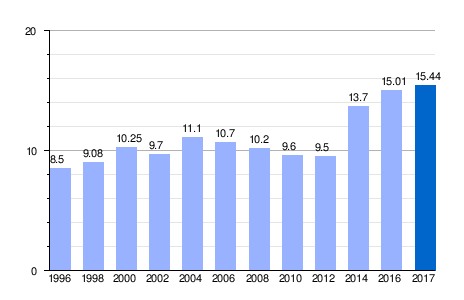 |
| Ref:[31] |
Infrastructure and others
The national parks have, in general, all the necessary and sufficient provision of means for their proper functioning and development. In addition to the equipment and infrastructures for public use, all the national parks of the National Parks Network have at least one administrative office and a basic resource for their maintenance, surveillance and own monitoring (vehicles, forestry machinery, technical material, etc.).
The data about the material resources are very scarce and outdated, since the last official report dates from 2013. As of 2013, the 15 national parks had 32 visitors centers, 58 information centers, 121 parkings, 157 lookouts and 67 entertainment areas.[32] Also, the vehicles fleet of the Network was 392 in 2013.[32]
Staff
Between 1918 and 1997, the staff in charge of the national parks was part of the General State Administration. The Constitution of 1978 established a decentralized system and in 1997 most of the regions assumed the managements of the active national parks whitin its territories. As of 2015, the National Parks Network staff was integrated by 1,908 people.[33] From those, 502 were firefighters and 426 surveillance and security.[33]
International affairs
World Heritage Sites
World Heritage Sites have enough universally recognized natural and cultural features that they are considered to merit the protection of all the peoples in the world. Spain is currently the third country with more World Heritage Sites, and the OAPN administers four of them:
- Garajonay National Park, Canary Islands.
- Doñana National Park, Andalusia.
- Pyrénées – Mont Perdu World Heritage Site, Aragón (shared with France)
- Teide National Park, Canary Islands.
UNESCO Biosphere Reserves
The OAPN also administers the Spanish Network of Biosphere Reserves (REBR). The REBR is integrated by the 52 Spanish biosphere reserves designated as such by the UNESCO.[34] Spain has many more biosphere reserves, but this are specially protected and all of them coordinated and supported by an independent agency, the National Parks Autonomous Agency.
Committees
The agency has two committees for a better coordination of the National Parks Network and to advise the agency.
National Parks Collaboration and Coordination Committee
Integrated in the General State Administration there is a National Parks Collaboration and Coordination Committee. This committee aims to deepen collaboration and coordination mechanisms, study possible common effects, reconcile the implementation of programs and actions in national parks, exchange information and experiences, and facilitate the dissemination of knowledge between the national parks administrations.[35] The committee is chaired by the Director of the National Parks Agency and it is integrated by the administrators of the national parks, twelve representatives of the agency and the administrators of the centers and other properties of the agency. The Deputy Director of the agency is also a member of the committee and it is the deputy chair of it.[36]
National Parks Scientific Committee
The Scientific Committee is the body of the OAPN in charge of scientifically advising on any question that may be raised from the Office of the Director of the Autonomous Agency, at the initiative of this or at the request of the national parks administrations.[35] The Director and Deputy Director who are the chair and deputy chair, respectively, are part of the committee. In addition to these, the committee is also integrated by twenty members appointed by the director for a four-year term.[36]
References
- "Royal Decree 1055/1995, of June 23, which partially modifies the basic organic structure of the Ministry of Agriculture, Fisheries and Food". www.boe.es. Retrieved 2019-10-06.
- "Juan José Areces, director del Organismo Autónomo Parques Nacionales". www.efeverde.com. Retrieved 2019-10-06.
- "Royal Decree 864/2018, of July 13, which develops the basic organic structure of the Ministry for the Ecological Transition". boe.es. Retrieved 2019-10-06.
- "Spanish National Parks Act of December 7, 1916" (PDF). www.boe.es. 8 December 1916. Retrieved 10 October 2019.
- "Royal Decree of August 16, 1918 creating the National Park of the Ordesa Valley or the Ava River and the Covadonga National Park". www.boe.es. Retrieved 2019-10-10.
- "Decree of January 22, 1954, creating the Teide National Park (Canary Islands)". www.boe.es. Retrieved 2019-10-10.
- "Decree of October 6, 1954, creating the National Park of the "Caldera de Taburiente", in the island of La Palma, in Santa Cruz de Tenerife". www.boe.es. Retrieved 2019-10-10.
- "Decree of October 21, 1955 creating the "Parque Nacional de Aiguas Tortas y Lago de San Mauricio", in the province of Lleida". www.boe.es. Retrieved 2019-10-10.
- "Forestry Act of 1957" (PDF).
- "Decree of October 16, 1969, creating the National Park of Doñana". boe.es. Retrieved 2019-10-11.
- "Decree 1874/1973, of June 28, which declares National Park to the Tablas de Daimiel and creates a zone of integral reserve of water birds within it". boe.es. Retrieved 2019-10-11.
- "Decree of August 9, 1974 creating the Timanfaya National Park, on the island of Lanzarote, in the province of Las Palmas". boe.es. Retrieved 2019-10-11.
- "Protected Natural Spaces Act of 1975". www.boe.es. Retrieved 2019-10-11.
- "Garajonay National Park Act of 1981". boe.es. Retrieved 2019-10-11.
- "Cabrera Archipelago Maritime-Terrestrial National Park Act of April 29, 1991". boe.es. Retrieved 2019-10-12.
- "Picos de Europa National Park Act of May 30, 1995". boe.es. Retrieved 2019-10-12.
- "Cabañeros National Park Act of November 20, 1995". boe.es. Retrieved 2019-10-12.
- "Constitutional Court Judgment 102/1995 declaring the fifth additional provision of Law 4/1989 void". www.boe.es. Retrieved 2019-10-12.
- "Sierra Nevada National Park Act of January 11, 1999". boe.es. Retrieved 2019-10-12.
- "Atlantic Islands of Galicia National Park Act of July 1, 2002". boe.es. Retrieved 2019-10-12.
- "Constitutional Court Judgment 194/2004". www.boe.es. Retrieved 2019-10-12.
- "Monfragüe National Park Act of March 2, 2007". boe.es. Retrieved 2019-10-12.
- "Sierra de Guadarrama National Park Act of June 23, 2013". boe.es. Retrieved 2019-10-12.
- "ESPACIO NATURAL SIERRA NEVADA - VENTANA DEL VISITANTE". www.juntadeandalucia.es. Retrieved 2019-10-12.
- "El parque :: Parque Nacional Tablas de Daimiel. Información, Actividades y Alojamientos". www.lastablasdedaimiel.com. Retrieved 2019-10-12.
- "Centros y fincas adscritos al Organismo Autónomo Parques Nacionales".
- Hosteltur. "Los Parques Nacionales recibieron más de 15 millones de visitantes en 2016 | Economía". Hosteltur: Toda la información de turismo (in Spanish). Retrieved 2019-10-12.
- "El Teide pulveriza un nuevo rércord de visitantes". abc (in Spanish). 2018-05-03. Retrieved 2019-10-12.
- "De los dos millones de visitantes de Picos de Europa, 700.000 acceden por Fuente Dé". El Diario Montañes (in Spanish). 2017-12-18. Retrieved 2019-10-12.
- Provincia, La. "Timanfaya y El Teide, las joyas de España". ocio.laprovincia.es. Retrieved 2019-10-12.
- "Visitor data to the National Parks 1996-2017" (PDF). www.miteco.gob.es.
- "Status Report of the National Parks Network (2011-2013)" (PDF). www.miteco.gob.es. 2013. p. 54. Retrieved 12 October 2019.
- "Report of the National Parks Network - 2015" (PDF).
- "La Moncloa. 19/06/2019. UNESCO approves three new biosphere reserves in Spain [Acting Government/News]". www.lamoncloa.gob.es. Retrieved 2019-10-12.
- "National Parks Act of December 3, 2014". www.boe.es. Retrieved 2019-10-06.
- "Order of the Environement Minister which establishes the composition, functions and operation of the National Parks Collaboration and Coordination Committee, the Coordination Commissions and the National Parks Scientific Committee". boe.es. Retrieved 2019-10-06.
